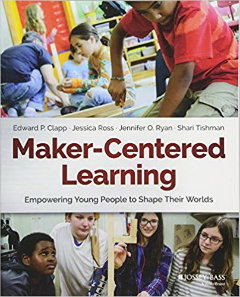Making: Empower Students to Shape Their Worlds
Maker-Centered Learning: Empowering Young People to Shape Their Worlds
By Edward P. Clapp, Jessica Ross, Jennifer O. Ryan and Shari Tishman
(JosseyBass/Wiley, 2017 – Learn more)

Although “making” has been with us for most of history, its recent elevation in the education community has made it a focal point of interest for many teachers and school leaders.
In Maker-Centered Learning, the authors provide us with information and ideas stemming from their work in the research group Agency by Design (funded by the Abundance Foundation and in cooperation with Project Zero). Here, the word agency refers to “the capacity, condition, or state of acting or of exerting power” (Merriam-Webster).
It is likely that the next wave of creating and entrepreneurship will come from students who hone their skills as makers, and thus the researchers have pursued three strands of inquiry into maker-centered learning, around three key research questions.

While the popular press sees the maker movement as important primarily to secure the future technological and economic standing of the United States, most of Agency by Design’s school interviews illustrated that discipline-specific (STEM) and maker-based knowledge (how to use tools, etc.) are instrumental but secondary to the dispositional outcomes of agency and character development.
Based on this preliminary information, the authors discuss their findings in relation to three research questions:
1) How do maker educators and leaders in the field think about the benefits and outcomes of maker-centered learning experiences?
2) What are some of the key characteristics of the educational environments and instructional designs under which maker-centered learning thrives?
3) What kinds of educational interventions can support thoughtful reflection around maker-centered learning and the made dimensions of our world? (p. 8 & 9).
An overview of content
Chapter 1 addresses the first question and goes through differences between stuff making and community making as well as the key character-building traits addressed in self-making through maker-centered learning environments.
Chapter 2 then focuses on the second question and addresses some of the key features in common among the various maker learning environments that they visited, which includes a discussion on resources, organization and tools (many sites don’t include a 3D printer or other “high tech”).
Chapters 3-5 address the third research question and speak more globally to ways of intervening rather than providing specific strategies to implement (with the exception of 4 frameworks provided in chapter 5).
Chapter 3 addresses the idea of agency. The authors define what this is and how to build the characteristics for maker empowerment. They note the importance of sensitivity to design dimensions of both objects and systems, and, most importantly, to seeing opportunities to act for the development of agency.
Chapter 4 then picks up with an exploration of the key parts of a sensitivity to design and addresses how our consumable, throw-away society has changed the way we look at the objects and systems in our lives — seeing that they may be controlling us more than we control them. The chapter also considers how to shift students’ thinking to seeing underlying design components…how things are designed, and why they are designed that way. The authors argue that this is a vital step to seeing our world as malleable and therefore to seeing opportunities to act (both with “stuff” and social issues).
Chapter 5 describes the frameworks that are needed to build the sensitivity to design and opportunity to act. The authors define these as looking closely, exploring complexity, and finding opportunities. They discuss how to embed these ideas in a general form as well as provide four specific strategies that can be used to build these skills (which like any skill must be built by repetition over time).
Clapp, Ross, Ryan and Tishman close the book with a summary of the information presented and address the ethics, equity, and sustainability of maker-centered learning in education. As part of its sustainability in education, they point out that in order for maker-centered learning to continue to have a place in schools (since it is not a content unto itself), there must be a way to demonstrate and document the outcomes achieved. They indicate that the next phase of their research will focus on assessment and documentation methods.
Maker-Centered Learning: Empowering Young People to Shape Their Worlds provides a well-organized and well referenced look at the role of maker-centered learning in education and provides a perspective that is different from that of the popular press.
Laura Von Staden is currently a Middle School Gifted Math and Science teacher in Tampa, Florida. She serves on numerous committees in her school district, works closely with the local university, and writes curriculum. She is also a PD consultant and previously served as an Exceptional Student Education Specialist and as a mentor. Prior to her Middle School education career, Dr. Von Staden was a research scientist in the field of Molecular Immunology.

































